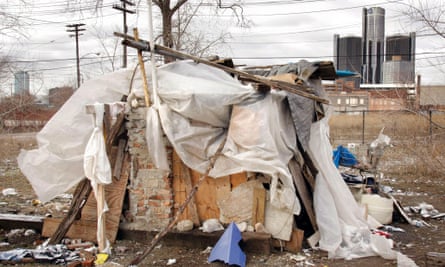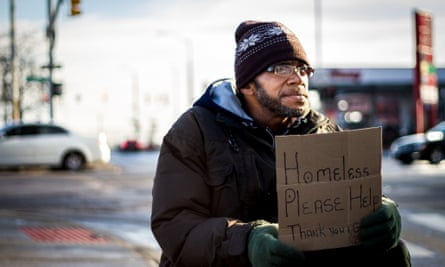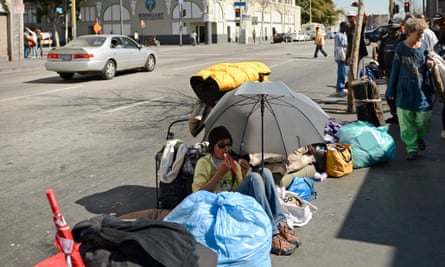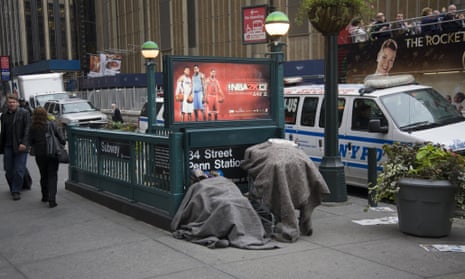At a soup kitchen in Detroit, a former crack addict in a wheelchair is explaining how he lost his legs. “They were amputated in 2000 because I had frostbite from sleeping on the streets,” says Clayton, 54. Fourteen years on from becoming a double amputee, Clayton is still homeless in his home town, but he’s been off drugs for more than a decade, and remains remarkably sanguine about his plight. “It ain’t easy sometimes, but at least I’m still alive,” he says, breaking into a smile.
It’s winter 2013 and we are in the Central United Methodist Church, a stone’s throw from Comerica Park, home of the Detroit Tigers baseball team. It is noon, a soup kitchen is in full flow, but outside it’s bitterly cold, December snow piled high on the streets, the Detroit River frozen. When dark falls, the temperature can plunge to -20oC.
Tonight, as usual, Clayton will sleep rough under a viaduct beside the Cobo Centre – a huge convention arena – a few blocks away from the soup kitchen. Run by volunteers from a homeless charity called the Noah Project, Clayton visits twice a week. As we chat over coffee he says he hopes to survive another brutal Michigan winter and eventually get a place of his own. Matt, a young Jesuit volunteer at the Noah Project, says there will be around 16,000 people without a home tonight in the Motor City in harsh conditions. A local church is planning a memorial service for homeless people who’ve perished on the streets.
And yet despite the Great Recession, the gutting of the auto industry and the city’s much-publicised bankruptcy, homelessness in Detroit has actually fallen (albeit by less than 1%) since 2010, according to the Detroit Rescue Mission Ministries. Nor is it the only city. Across the US, homelessness in cities is dropping almost across the board.
Part of the credit for this apparent success must go to Barack Obama’s Opening Doors programme, which the Department of Housing report concluded had made “significant progress in spite of tough economic times”. Launched in 2010, Opening Doors was the country’s first comprehensive strategy to prevent and end homelessness. It set the target of ending chronic homelessness and homelessness among war veterans by 2015, and among families with children by 2020.

Central to Opening Doors is a controversial idea that has picked up support in cities worldwide, especially in the Scandinavian countries, Germany, France and the UK. Known as Housing First, it prioritises moving homeless people straight from the streets into a home, as opposed to other programmes whereby people are mandated to address certain personal issues prior to entering housing.
“With Housing First, the idea is to help people find permanent housing right away, without conditioning this housing on sobriety, mental health treatment, employment, or anything else. Then, continue working with them on all of these issues once they are stably housed,” says Jake Maguire of Community Solutions, which ran the 100,000 Homes Campaign – an initiative across 186 cities, counties and states that, earlier this year, met its goal to find roofs for 100,000 homeless Americans. “This is important, because typically it has been done the other way around. The data overwhelmingly reveals the counterintuitive fact that Housing First ends homelessness permanently, while treatment first rarely ends it at all.”
The numbers back it up. The 100,000 Homes Campaign announced in August that homelessness among US war veterans dropped below the 50,000 mark for the first time since 2010, falling to 49,933 – a 30% drop during that period. “What works to end veteran homelessness will work to end all homelessness,” says Becky Kanis, a former army captain and until recently campaign director. “Permanent supportive housing and rapid rehousing are proven strategies, and they actually save taxpayers money.”
Not everyone agrees. Although Housing First was adopted by the George W Bush administration, it remains unpopular on the right of the political spectrum, and not just among people who believe that citizens should “earn” state support. The initial cost of Housing First is expensive, and many people are resistant to the idea of providing housing for homeless drug addicts without first enrolling them on to a rehabilitative programme.
This strikes at the heart of the debate about the root causes of homelessness, which is fundamentally about two arguments, according to Nicholas Pleace, a housing policy expert at the University of York and researcher with the European Observatory on Homelessness, an arm of the European Federation of National Organisations Working with the Homeless (Feantsa).

“There is the idea of essentially structural causation: economic downturn, cuts to welfare, service and benefits, limitation with services with, for example, regards to mental health and the care system,” Pleace says. “But then you’ve also got what we call individual pathology, which tends to be argued by those on the right, more about individual actions, choice and characteristics.”
One of the most vocal opponents of Housing First for its apparent willingness to give homeless people an easy ride, is former New York mayor Michael Bloomberg, who gave homeless people one-way tickets out of town, charged families for using emergency shelters and evicted people from these shelters who broke curfew. By 2007, 550 families left New York with tickets paid for by the taxpayer.
Critics of Bloomberg (in office from 2002-2013) say his move away from providing permanent housing has been fundamental to New York’s steep rise in homelessness. In 2004, Bloomberg pledged a comprehensive effort to dramatically reduce homelessness, but the Coalition for the Homeless said rates subsequently rose 80% to become the highest since New York began keeping records 30 years ago. They say he encouraged gentrification in New York while cutting off homeless families from priority access to public housing and Section 8 vouchers, which pay two-thirds of rent in private apartments for low-income residents. (The city’s current mayor, Bill de Blasio, has essentially refunded the programme, and plans to move sheltered families into their own apartments via new rent subsidies.)
Similar issues bedevil London. As cuts to housing benefits bite, rents spiral upwards and luxury property development continues apace, Crisis estimates 6,508 people slept rough in the UK capital in 2013, a 77% rise on 2010. “Thousands of people are suffering because of cuts to housing benefit and a woeful lack of affordable housing,” says Matt Downie, director of policy and external affairs at Crisis. “Shamefully, instead of receiving the help they need, the law in England means that many homeless people are turned away by their councils because they are not considered a priority for housing help.” London is just one of many desperate British cities that has turned to Housing First for a solution.

It doesn’t work perfectly. In Los Angeles, where the concept of Housing First originated in a 1988 project called Beyond Shelter, homelessness has also risen sharply. Thousands of men, women and children are sleeping in places deemed unfit for human habitation: alongside freeways, in cars and vans, under overpasses and beside rivers.
Housing First simply can’t tackle the problem – especially not in Skid Row, the downtown Los Angeles area synonymous with destitution. “Emergency services used to be just that: emergency services. Someone could get overnight shelter, a bed, some food and clothing,” says community organiser Eric Ares, “but because there is increasingly no way out of homelessness, people become dependent on emergency services permanently.
“We have a combination of a service model that doesn’t allow people to get out of homelessness; an economy and housing market that tries to attract higher earners; and not having available housing stock that is affordable. At the same time,” he goes on, “there is a movement to destroy public housing and convert it to private housing. And we’ve had a huge economic recession.” Although Housing First is being pushed by some organisations, most still focus on emergency shelters. “This is because of the scale of the issue in LA: it is so big that it’s hard to meet the urgency in terms of Housing First.”
The nations where homeless is best understood, monitored and addressed are, not surprisingly, in nations with the most developed welfare systems – Scandinavia, Germany and France. In Europe, Housing First has developed into “Housing Led”, in which housing is considered a human right and all efforts are focused on getting homeless people settled in homes.

Homelessness remains a problem in all EU states, and has risen in 15 countries over the past five years. But Housing Led projects have already proved successful in Finland, Denmark and Scotland, where homeless applications in the last of these – a system whereby people notify their local authority of impending homelessness – fell by around 10% from 2012-13. Glasgow saw a 9% drop, following an 11% drop on the previous year. Housing First, and indeed Housing Led, are likely to be hot topics when 300 delegates gather in the city of Bergamo, Italy from 24-25 October for the Feantsa 2014 Policy Conference.
The fight against homelessness has thrown up many ideas and proposed solutions over the years. Recently, there has been a raft of design-led solutions, from housing people in shipping containers to the latest craze for tiny houses. Maguire warns against getting caught up in them. “People just have this intuitive idea that homeless people need something different than the rest of us,” he says. “It used to be a special building or program, now it’s a sexy tiny home in a separated area. Tiny houses are slower, more expensive and far less scalable than using existing housing stock … and they just isolate the homeless from everyone else.”
Street papers, whereby homeless people sell a magazine on the street to create an income, are still seen as one of the most effective tools in fighting homelessness. Glasgow – hot on the heels of its Housing First pilot successes – hosted the International Network of Street Papers (INSP) 20th anniversary conference in August, with nearly 100 delegates from as far afield as Osaka and Buenos Aires; the organisation supports 123 street papers in 41 countries.
The first street paper was Street News in New York, launched in 1989. Since then the concept has spread. In fact, further innovation has come through the street papers. In Nuremberg, for example, the street paper Strassenkreuzer invites homeless people to attend university lectures; in Munich, BISS magazine pays its vendors pensions, and pays for funeral services and burials for homeless people who die on the streets.
Street papers have also been at the forefront of exposing what might be considered the “third way” of dealing with homelessness: criminalisation. Scores of US cities particularly have adopted punitive measures to deal with destitute people, such as police sweeps to confiscate personal property, or making panhandling (asking for money on the street) illegal.

Of 234 American cities, 40% make it a crime to sleep in public spaces, according to the National Law Center on Homelessness and Poverty. Meanwhile, Seattle-based Real Change reported that around 100 tent encampments have been closed throughout the US, with only eight “tent cities” now considered legal. In Nashville, Tennessee, the Contributor street paper investigated 17 cases of homeless people being given criminal records, ostensibly for criminal trespassing and obstructing a highway.
Other cities have been even more callous. In Detroit, where Clayton spoke of his personal struggles, the ACLU claimed last year that police officers were routinely “kidnapping” homeless people in vans from tourist areas such as Greektown, then dumping them miles from their area – sometimes outside the city limits – with no way of getting back. This in a city where at least one third of the city’s 16,000 homeless people are thought to be mentally ill.
The UN has criticised these policies, which display none of the ingenuity or flair of the street papers or Housing First advocates, whose methods, while not perfect, have at least been shown to reduce urban homelessness. Maguire says it’s important to understand the opposition. “Housing First opposition is typically rooted in a sense that it feels wrong or backwards to subsidise housing for someone with active mental illness or a drug problem,” he says. “We’re actually pretty sensitive to how difficult these feelings can be to overcome, but the data is so clear on this: 85% of Housing First participants do not return to homelessness, and many end up tackling mental illness, unemployment or addiction in housing and on their own terms.
“Housing First is counterintuitive, and I think it’s really fair to admit that, but at the end of the day, would you rather be right, or would you rather end homelessness?”






Comments (…)
Sign in or create your Guardian account to join the discussion